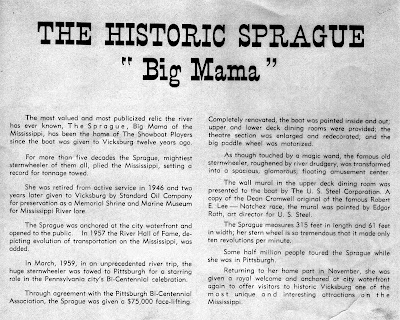About 20 years ago, the venerable German photographic company, Agfa, made a black and white transparency film named Scala. It was intended to be projected, meaning to be used for black and white slides that would be projected on a screen. I tried Scala several times and liked it, but did not use it regularly. The Scala was ISO 200 and needed to be processed at a laboratory with the correct Scala chemicals. Possibly you could buy the chemicals for home use, but I never checked. Recently, I rediscovered my 1997-vintage Scala 35mm slides and did a test scan with my Plustek 7600i scanner. They looked really nice and I scanned most of the roll. Here is a semi-random tour of Vicksburg, Mississippi.
In the 1990s, three river boats regularly visited Vicksburg, the
Mississippi Queen, the
Delta Queen and the
American Queen. All three stopped service during the economic downturn of 2007-2009. The
Mississippi Queen was cut up for scrap in 2011. The
Delta Queen, which was made of wood, can no longer be used for passenger traffic. But the
American Queen is now (as of 2016) back in service with regular stops at the Vicksburg waterfront on the Yazoo diversionary canal.
In 1997, the Harrah's Vicksburg Casino was moored in its cofferdam on the canal side of the floodwall. The hotel was on land, but the gambling facilities had to be on floating plant. The subsequent owners of the casino filed for bankruptcy, and the barge is now moored in the Yazoo River near the Ergon petroleum refinery (I assume awaiting scrapping).
Vicksburg's famous Attic Gallery was formerly at 1404 Washington Street above Michael's Jewelry. The Gallery was a great place and packed tight with sculpture, paintings, and stuff.
Attic Gallery now is at 1101 Washington Street and almost as tightly packed with interesting things.
This was the steel framing for the Vicksburg Convention Center on Mulberry Street.
This photograph shows some of the earthwork done for the convention center. The Bunge Corporation grain elevator on Levee Street is in the distance, with the Yazoo Canal beyond.
Oak Street is one of Vicksburg's older residential neighborhoods. No. 3517 is an early 20th century duplex.
Pearl Street parallels the railroad tracks. This cottage at 2521 was also a duplex and still had the characteristic split porch pillars that can be seen in many older Vicksburg houses. As of October 2016, this building is still occupied. Many other shotgun shacks and cottages that once lined Pearl Street are gone.
These almost-twin shotgun shacks are at 1300 and 1302 Harrison Street. As of 2016, they are still extant.
An old Plymouth has been parked in the garage of 920 National Street for decades. I have never seen any occupants, but someone maintains the grounds and house, so it is not abandoned.
This is the railroad cut between Belmont and West Pine Streets. I took this photograph on Feb. 3, 1997, just after an ice storm draped the kudzu and branches with ice.
This is North Fisher Street, also draped with ice.
By the time I took this picture of Letitia Street, the ice had already melted from the street.
This little church on Yazoo Street was condemned and scheduled for demolition as of mid-2016.
The cottage at 1101 Stouts Street, near the Yazoo Street church, is also gone.
Finally, we have another duplex cottage at 2729 Alma Street. The house no longer exists, and the lot has reverted to jungle.
Sadly, Agfa is gone, another victim of the digital imaging era. The company was founded in 1867 as Aktiengesellschaft für Anilinfabrikation and renamed Gevaert & Co. in 1894. Once a prominent European manufacturer of film, papers, and chemicals, Agfa-Gevaert sold their consumer imaging division in 2004 to a management buyout. But within a year, the new AgfaPhoto GmbH had filed for bankruptcy, ending over a century of top-quality film and paper manufacture. I still use their Rodinal film developer, which was invented in 1891 by Dr. Momme Andresen. Fortunately, Rodinal is still made, now by Adox, another old-line photo company. How many other 120-year-old consumer products can you buy? Freestyle Photographic Supplies in Los Angeles sells Rodinal as well as Adox and other traditional black and white films, but Scala is gone forever. Shoot more film!
All of these photographs were taken with a Leica M3 rangefinder camera, most with 35mm or 50mm Summicron lenses. I wrote about
Leicas in a 2014 post.
 |
| Example of a 5-pack of 120-size Scala film. |






















































